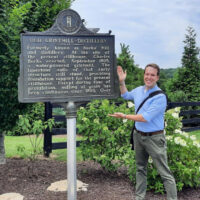Technicians at the Blue Grass Army Depot in Madison County have started destroying chemical weapons stored at the site.

The first munition neutralized this month was mustard gas, a blistering agent that was widely used during the First World War. During that conflict, Kentuckians knew the dangers posed by that weapon as local soldiers fell victim to it and other poisonous gases.
In June 1919, a historian with the Kentucky Council of Defense determined that 3,708 Kentuckians had been wounded or gassed on the Western Front.
Luther Lee Collins was one of them. Although the United States didn’t enter the conflict until 1917, Collins suffered from poison gas two years earlier. Impatient to join the war effort, the Bourbon County native enlisted in the Canadian Royal Highlanders in Montreal in 1915. Sent to France, he was gassed and wounded in the leg. He spent eight weeks in the hospital before returning to the United States.
“War is a terrible thing,” Collins later said. He added that “It is enough to tear one’s nerves to pieces and make him wish he was back home.”
After America officially entered the war, news about individual soldiers succumbing to gas began appearing in hometown newspapers.
In early 1918, for example, journalists reported that Private Addison W. Jones was the first soldier from Hopkinsville to be injured in France. Jones had been gassed and was recovering in a hospital.
Those exposed to chemical attacks frequently faced a difficult recovery. The father of one Kentuckian wrote that his son “was totally blind for two weeks and that his lungs are still painfully affected from the inhalation of the deadly vapor.”

While some soldiers remained in hospitals close to the front, those needing more time to recover returned to the United States. Some convalesced at Camp Zachary Taylor in Louisville. Several Kentuckians were among the patients, including Harrison Scott of Mt. Sterling, who said, “I sure am glad to get back to Old Kentucky.”
For many affected by poison gas, the fear and trauma that it caused was profound; many at Camp Taylor suffered from post-traumatic stress disorder (PTSD). This included John Rippinger of North Aurora, Ill., who had been wounded once and gassed twice. One reporter said that Rippinger “was shell shocked, and his nerves are still all torn to pieces.” Once, Rippinger heard a truck motor backfire. “He began to shake as with an ague,” a reporter wrote, “and over his face came the most terrible of expressions. For a second it reflected the horrors of what he had passed through.”
During the reporter’s visit, Rippinger spoke of “the terrible mustard gas that sweeps down in the valleys, into the dugouts and trenches, biting its way through the very clothes and into the bone, burning up the lungs and leaving men doubled up in horrible agony, and it sinks into the earth. The gas turns a man’s arm black. The arm must be taken off immediately to prevent the spread of gangrene. It burns wherever there is a drop of perspiration, and if the gas mask is not adjusted in time it seems to tear, the very soul from its victim, searing the lungs and throat.”
Rippinger bore deep psychological scars, yet he survived. Others were less fortunate. Private Robert Rone, for example, returned home to Morgantown after being wounded and gassed. He died there in October 1918 from pneumonia, leaving a widow and two children. It is likely that the damage that the gas wrought upon his lungs contributed to his demise.
Harry Hignite of Danville also succumbed. “Death came from his being gassed last March [1918] while in action on the western front,” his obituary stated. Hignite died nine months later. Another reporter commented, “He was returned to this country for treatment but grew gradually worse until the end came.”
The effects of poison gas—and the trauma that it caused—sometimes led to tragedy years after the conflict. In February 1925, 30-year-old William Brugger of Dayton, Ky., was found dead in that town’s St. Francis Cemetery.
“Life was bitter,” Brugger’s obituary stated. “Shell-shocked and gassed in battle during the World War and unable to obtain employment, he had long threatened, according to members of his family, to take his life.”
At the time of his death, Brugger had a crucifix and a prayer book in his hands. While the family believed that he had gone to the cemetery to kill himself, the Campbell County coroner, perhaps sparing the family from additional heartache, said that Brugger had died from heart disease. Regardless of how he passed, it was evident that Brugger also suffered from PTSD, which affects a large number of veterans today.
Because of the experiences endured by these Kentuckians more than a century ago, modern residents should commend the efforts of the Blue Grass Army Depot for eradicating the poison gas under their care. It is good that the chemicals stored there, which can kill, maim, and are “enough to tear one’s nerves to pieces,” will finally be eliminated.
Stuart W. Sanders is the Kentucky Historical Society's Director of Research and Collections. His latest book, “Murder on the Ohio Belle,” examines Southern honor culture, vigilante justice and the Civil War through the lens of an 1856 murder on a steamboat. Find him on Twitter @StuartWSanders.





